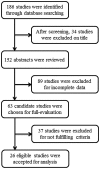Tumor size predicts prognosis of head and neck synovial cell sarcoma
- PMID: 25435996
- PMCID: PMC4247063
- DOI: 10.3892/ol.2014.2634
Tumor size predicts prognosis of head and neck synovial cell sarcoma
Abstract
Head and neck synoviosarcoma (HNSS) is uncommon. To the best of our knowledge, the specific clinicopathological characteristics, treatment outcome and prognostic factors of HNSS were uninvestigated at the time of writing, so a meta-analysis was performed. An online data collection was carried out using PubMed and Google Scholar. Studies that reported primary HNSS and the treatment, follow-up time and outcome were chosen for the present study. In total, 93 cases from 26 studies were included for analysis. The study sample consisted of 55 males and 38 females and the median age was 32.1 years (range, 4-76 years). The median follow-up period was 62.1 months (range, 1-373 months). The tumor size was correlated with local recurrence and metastasis of HNSS, as well as with mortality (P=0.001, P<0.0001 and P<0.0001, respectively). The three-year, five-year and 10-year survival rates were 82.1, 80.4 and 78.2% for treatment with surgery alone, and 88.5, 85.5 and 82% for treatment with surgery plus radiotherapy, respectively. A significant tumor size-dependent difference was found between the overall survival (OS) rates (P<0.0001), as tumors that were >5.0 cm in diameter were associated with a worse OS rate (hazard ratio, 6.460; 95% confidence interval, 206-18.917; P=0.001). The tumor size was found to be an independent adverse prognostic factor for the OS of HNSS patients. In conclusion, surgical excision is a mainstream treatment of HNSS and post-operative adjuvant radiotherapy improves the OS rate of HNSS patients.
Keywords: head and neck; meta-analysis; outcome; synoviosarcoma; treatment.
Figures



References
-
- Gurney JG, Young JL, Jr, Roffers SD, et al. Soft tissue sarcomas. In: Gloeckler Ries LA, Smith MA, Gurney JG, Linet M, Tamra T, Young JL Jr, Bunin GR, editors. Cancer Incidence and Survival Among Children and Adolescents: United States SEER Program 1975–1995. National Cancer Institute, SEER program; Bethesda, MA, USA: 1999. pp. 111–123.
-
- Ichinose H, Wickstrom JK, Hoerner HE, Derbes VL. The early clinical presentation of synovial sarcoma. Clin Orthop Relat Res. 1979:185–189. - PubMed
-
- Spillane AJ, A’Hern R, Judson IR, Fisher C, Thomas JM. Synovial sarcoma: a clinicopathologic, staging, and prognostic assessment. J Clin Oncol. 2000;18:3794–3803. - PubMed
LinkOut - more resources
Full Text Sources
Other Literature Sources
